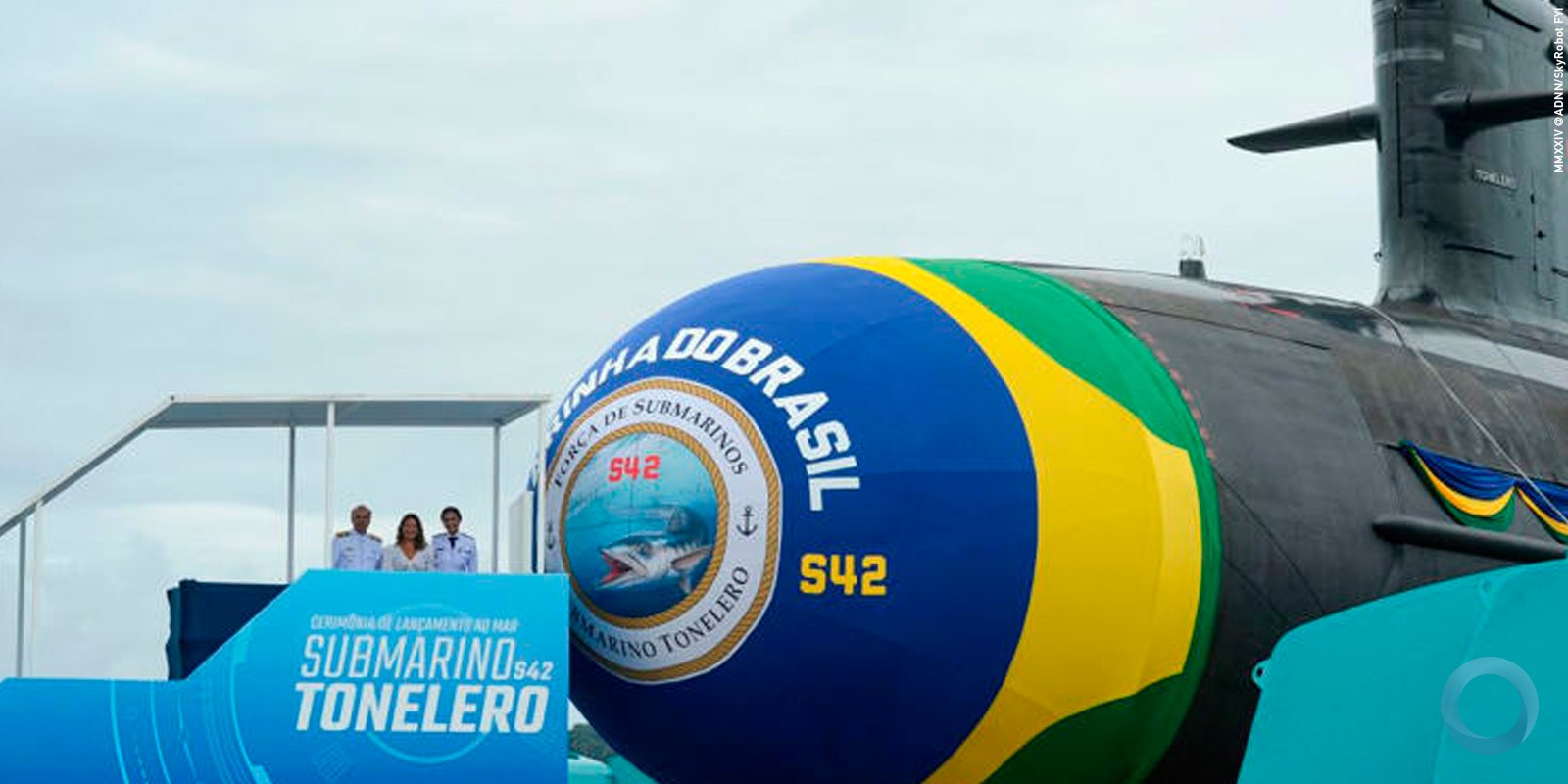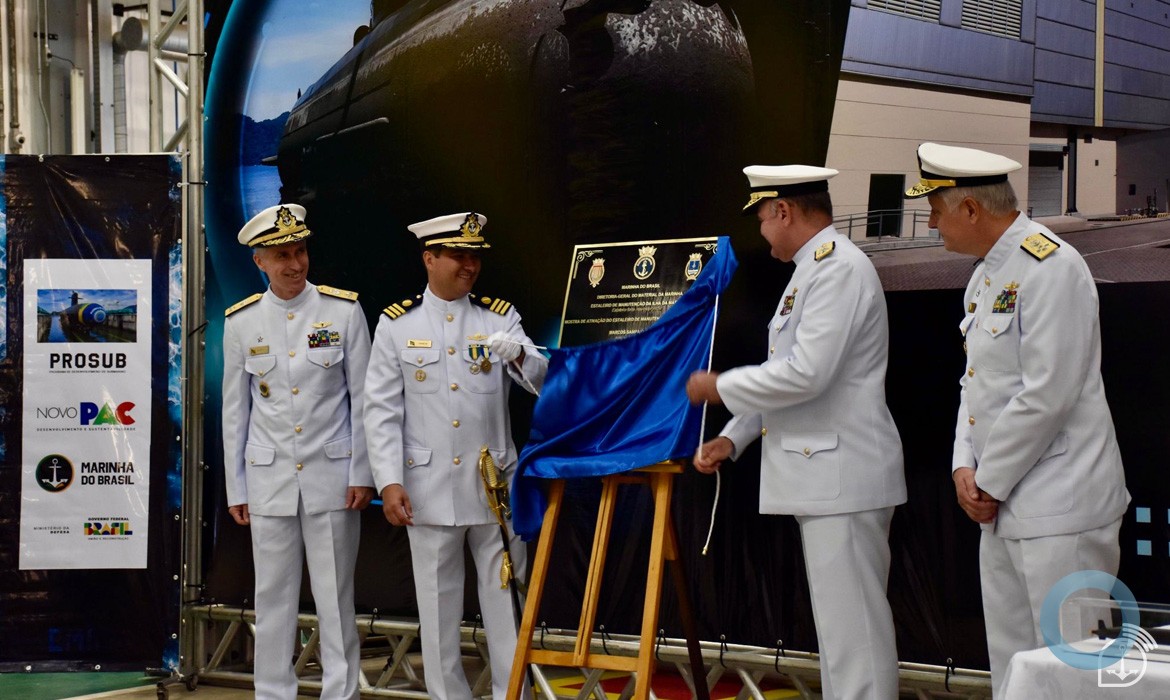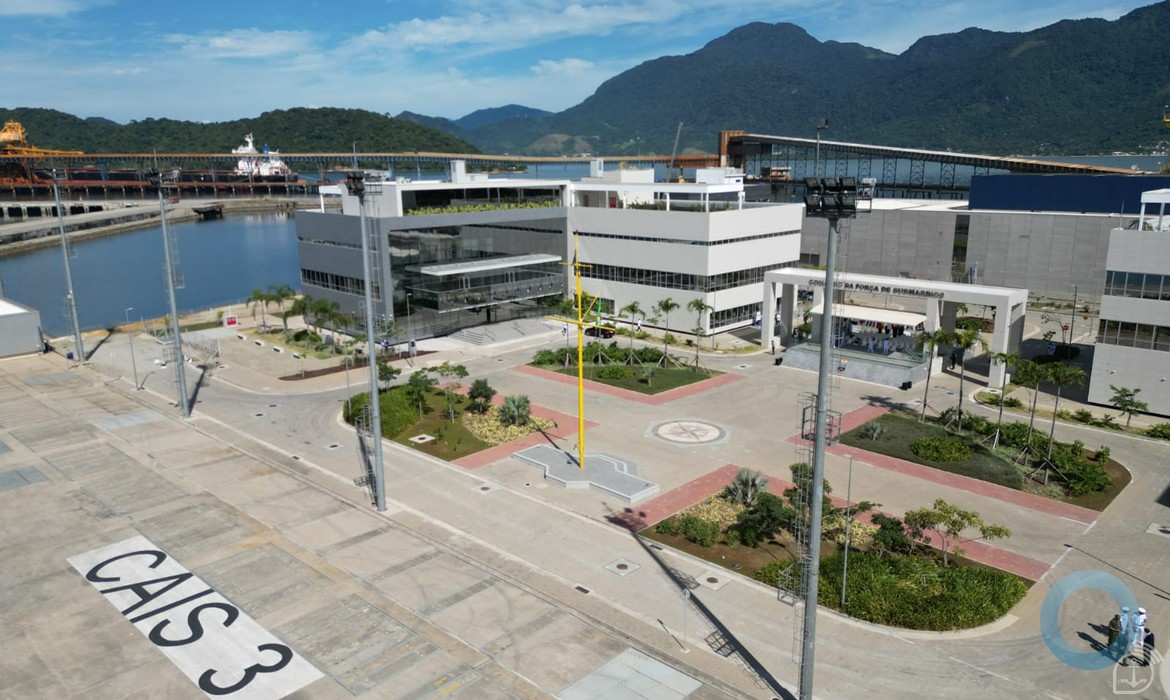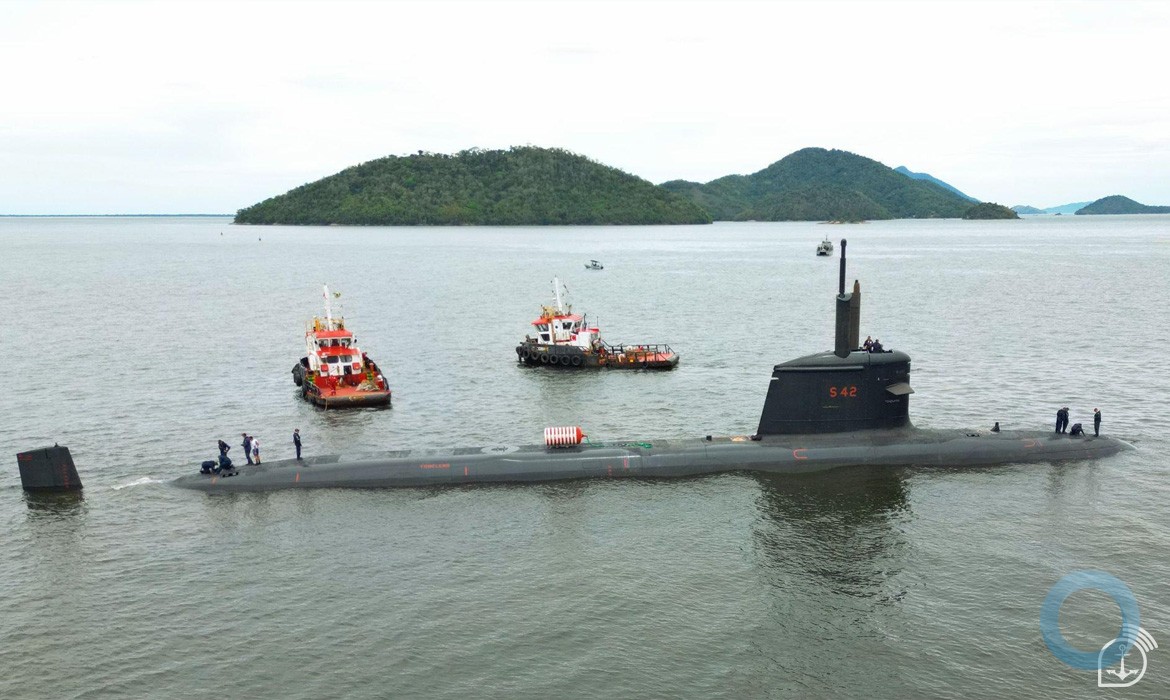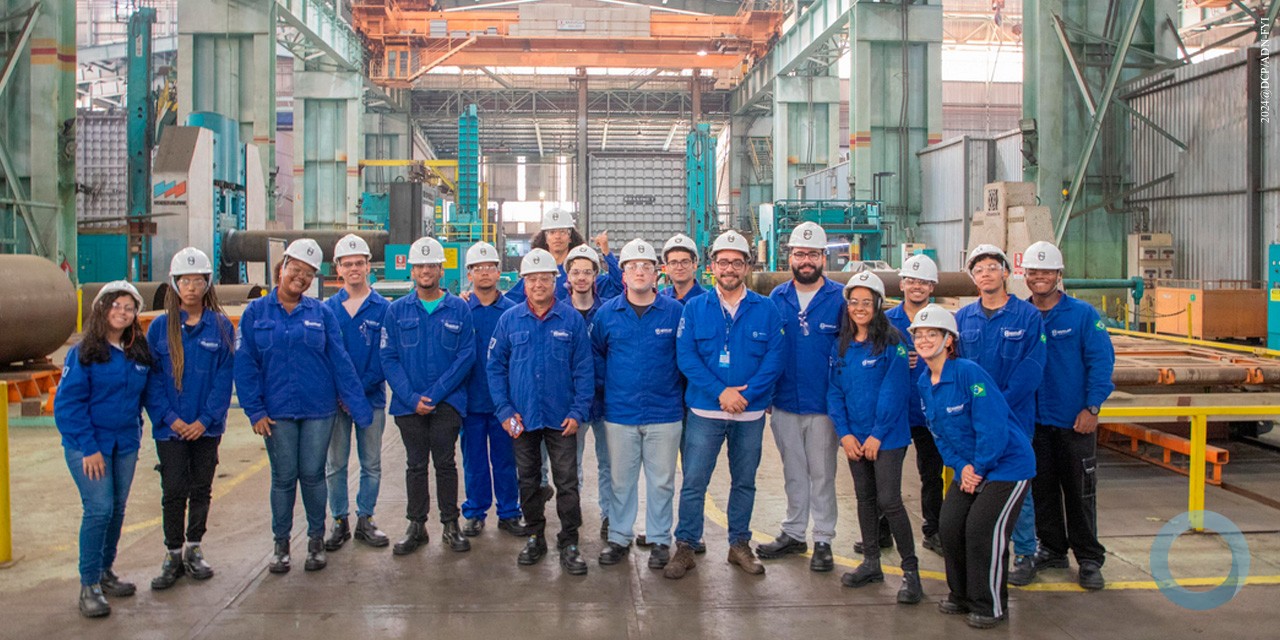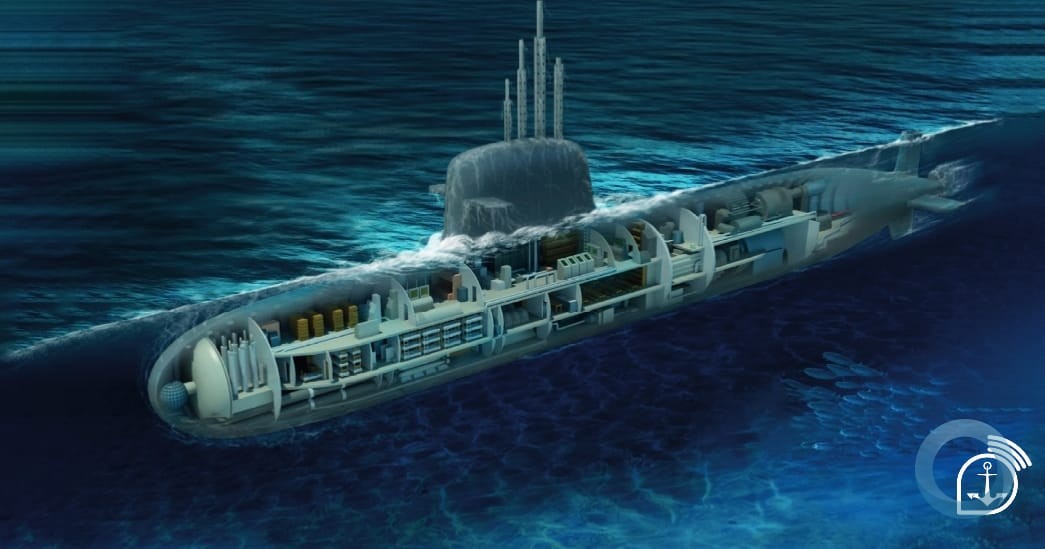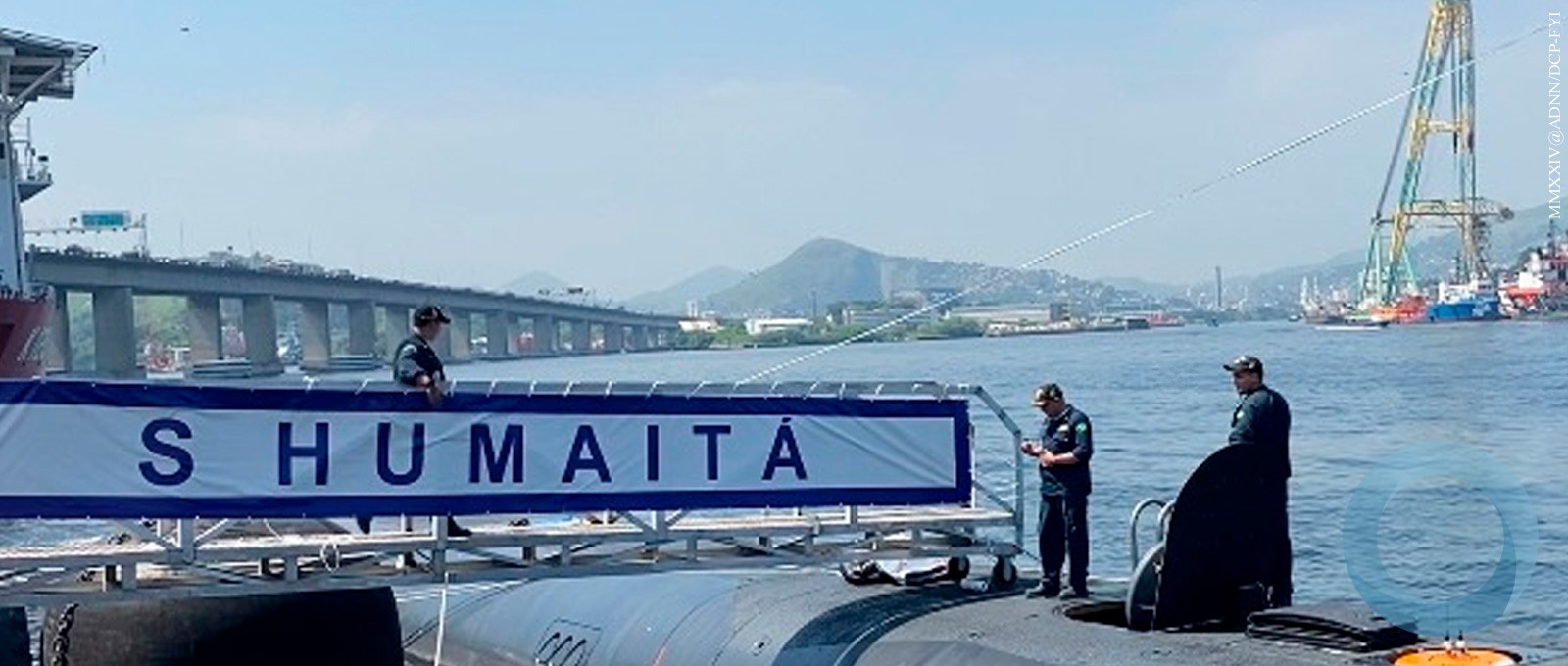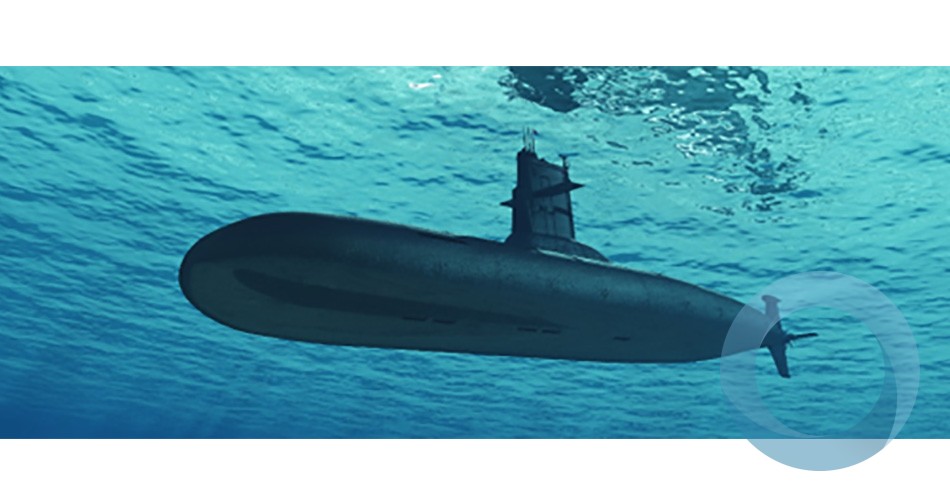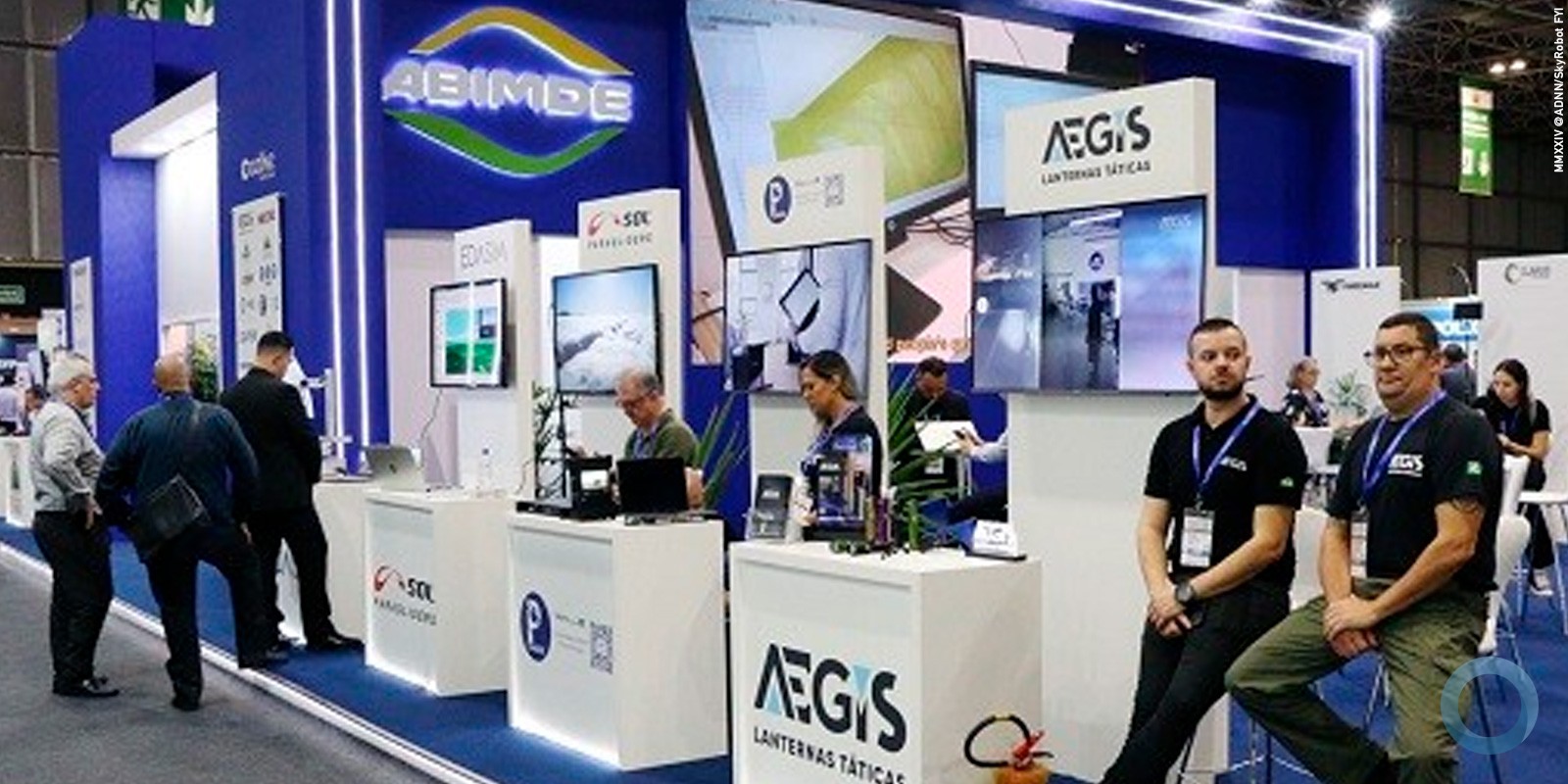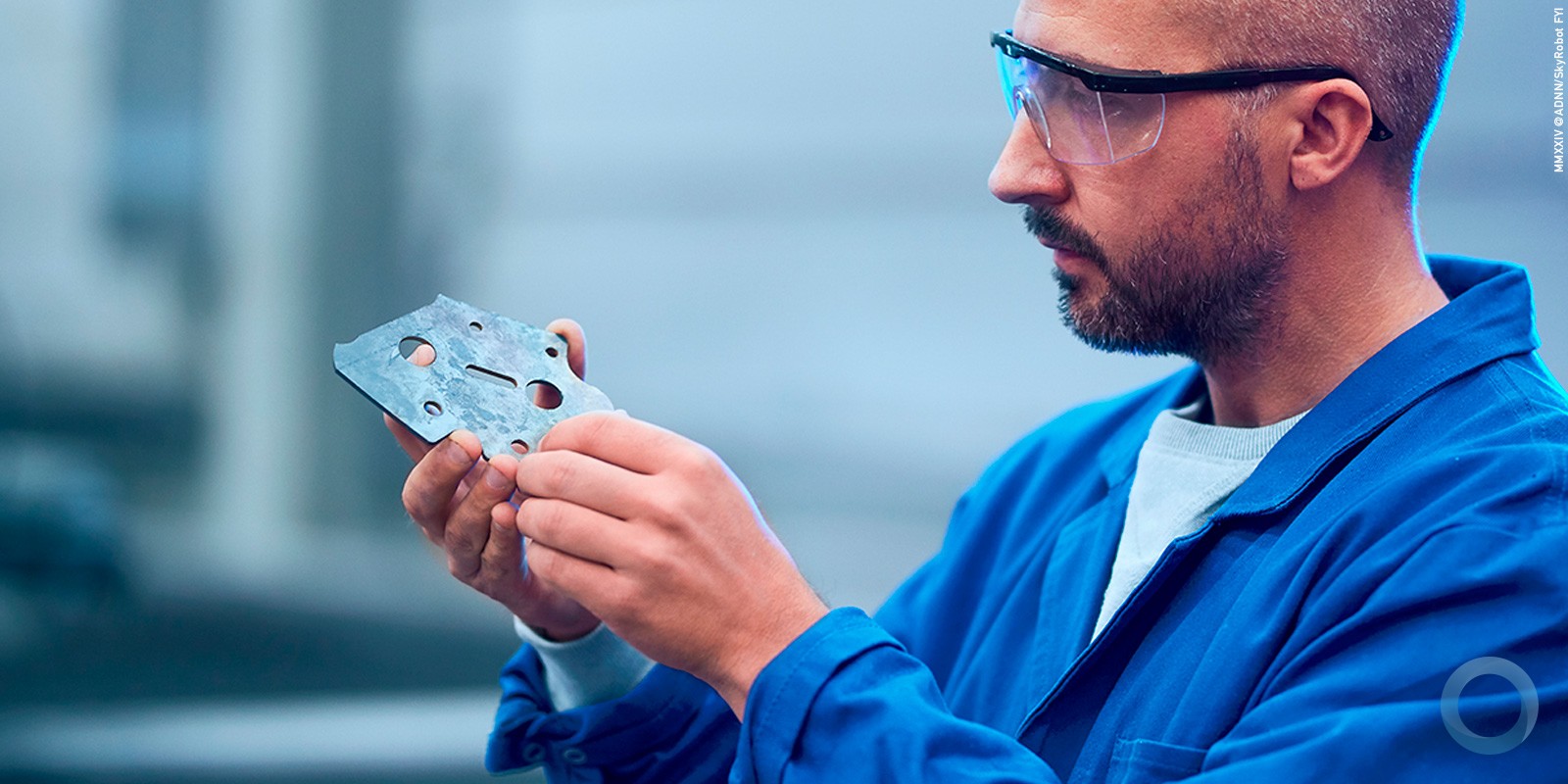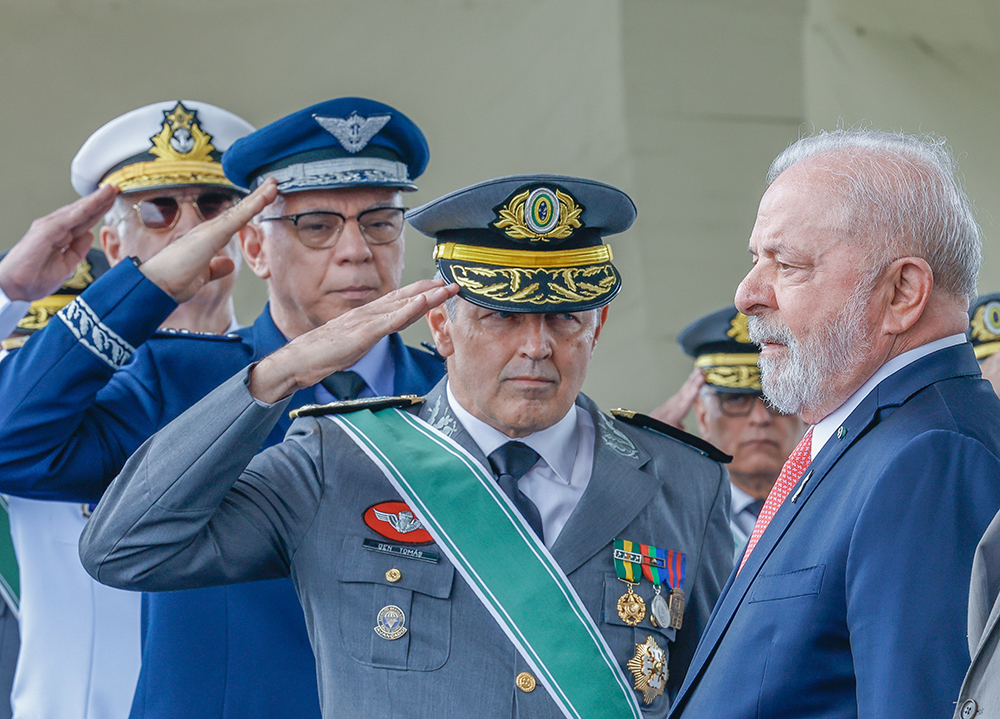The S-40 Riachuelo is the result of Brazilian Navy’s hard work, synergy and capacity
Fernanda Corrêa
PhD on Political Science, specialized in Strategic Studies by the Fluminense Federal University
Advisor for Strategic Planning at Amazonia Azul Technology and Defense.
Translation and editing: Nicholle Murmel
DefesaNet Staff
Last Friday, December 14th, the Brazilian Navy hosted the launching ceremony for the S-40 Riachuelo conventional submarine. It is the first of four Scorpéne-class units acquired via the Technology Transfer Agreement signed between Brazil and France back in 2008.
As per the terms of the Agreement, both nations would partake in technology transfer in order to design four diesel-electric and the hull and operation systems for one nuclear-propelled ship. Except for Riachuelo, all subsequent submarines will be built and assembled in Brazil. The name of the recently-launched S-40 is a reference to the naval battle of Riachuelo – a decisive episode in the Paraguay War (1864-1870) where the Brazilian Navy had a fundamental role.
After Riachuelo, the next ship due for launching is the Humaitá, in 2020, then Tonelero in 2021 and Angostura in 2022. Last, but not least, the nuclear submarine, dubbed Alvaro Alberto – after the nuclear technology precursor Navy Admiral – will be launched in 2029. The nuclear-propulsion components will be entirely developed by the Brazilian Navy within the institution’s labs and research centers. Besides transmitting, knowledge, technical information and know-how in several fields, the Agreement also encompasses the demand for training of Brazilian engineers and technicians, both in Brazil and France, as well as technical support provided by French company Naval Group – former DCNS – until Brazil’s Submarine Development Program (PROSUB) is complete.
How the program works
The Program was created by the Brazilian Navy in order to meet the directives defined by the National defense Stategy (END, in Portuguese), which prioritize sea use denial above other strategies, such as control over ocean areas or power projection. The initiative is distributed in management fronts: first, the four convenctional submarines, the platform system for the nuclear unit, and the construction of the shipyard and naval base for these new ships. The PROSUB is managed by the Brazilian Navy via partnerships between the government and the great companies from the private sector, both Brazilian and foreigner.
Back in 2009, the Brazilian Navy established the General Management Office (COGESN, in Portuguese) for the PROSUB. With its approval, the Naval Group then selected Brazilian companies to partake in the technology transfer process. Among the expertise areas the Navy planned on nationalizing were safety, air cleansing, life support, combat weapons, electric and automation systems, as well as propelling and platform management systems, hydraulics, air compression and mechanics. A good number of Brazilian companies had risen to the demands, lured by the offsets the PROSUB would bring.
Among the Naval Group facilities engaged in the Brazilian Navy program are the Lorient industrial center, where the submarines are designed. They are built in Chergourg and the strategic equipment to be installed comes from Ruelle. The diesel-electric engine and propulsion systems are vuilt in Nantes-Indret and the combat systems are developed in Toulon. Back in 2010, former DCNS established, in Lorient, the Submarine Design School for the Brazilian Navy; since then, the facility – as well as other cities – has welcomed many engineers and technicians both military and from partner companies for knowledge and technology transfer.

Future S40 Riachuelo Submarine Crew during the cerimony at Itaguai Shipyard
The PROSUB team
The Naval Group is one of the leading companies in conventional submarine design. However, it is important to point out that the Socrpéne-class model that has been exported to Brazil is different. The original design was for a 60 meter-long, 1.700 ton ship. The version sold to Brazil is 72 meters long and weighs 1.870 ton, including the diesel-electric engine and torpedoes. Other novelty is the extra section, designed by Brazilian engineers – that allows the ship to carry 35 crewmembers. Our conventional submarines also have 70-hor endurance and maximum depth of 300 meters. Not only are the PROSUB ships larger, they also meet specific demands from the Brazilian Navy, which include surveillance and protection of the entire Brazilian coast (8.500 kilometers) from North to South, deep underwater and with greater endurance and combat range.
Another important player in this entire process is the Ezute Foundation. The organization had a two-step participation in the submarine program. Back in 2011, the foundation sent nine engineers to France for project specification works on the combat systems for the Riachuelo-class ships. The second step placed part of those engineers on the direct development of a few modules of the software for the combat management system. Those modules will allow tactical communication between the new submarines and all other operating assets in the Brazilian Navy.
As a private sector partner, Naval Group had chosen the Norberto Odebrecht Construction Company to take part in two consortium-type ventures established as specific purpose entities: the Itaguaí Construções Navais (ICN) and the Baía de Sepetiba consortium. The Brazilian company had been chosen due to its globally renowned history of successful construction and industrial projects. The initial plan was for Odebrecht to build the shipyards and naval base in the Itaguaí area (in Rio de Janeiro state) based on a French project. The Baía de Sepetiba consortium became the integrator between all parties, both military and civilian, involved in the PROSUB.
State-run NUCLEP – a company associated with the Brazilian Science, Technology, Innovation and Communications Ministry – is in charge of assembling the heavy machinery for the five submarines commissioned to France. NUCLEP’s experience in building the five current conventional submarines operated by the Brazilian Navy was the main reason for Naval Group to choose it as a partner in the submarine program.
As for the AMAZUL – associated with the Ministry of Defense via the Brazilian Navy Command – the company will be responsible for the integrated control and weapons system, plus specifications of the future nuclear submarine; as well as the concept design for the Radiologic Complex for the Itaguaí shipyard as well as the naval base at the same location – that’s where the nuclear submarine will be refueled.
One of the main positive consequences of the PROSUB is providing the Brazilian defense industry with cutting-edge technology, as well as prioritizing the acquisition of locally-built components and equipment. That will contribute to the improvement of strategic industrial sectors in terms of economic development.
A few important marks
On May 2010, former DCNS, now Naval Group commenced first metal-cut for sections three and four, which would later become the bow of the S-40 Riachuelo. On July 16th 2011, NUCLEP began the first metal-cut for the ship as well.
On March 1st 2013, I, personally, did the coverage for the opening of the Metal Structures Construction Facility (UFEM, in Portuguese) as Defesanet’s guest correspondent. The factory is located beside the NUCLEP’s own facilities. The industrial complex is comprised of 45 buildings in a 97.000m² area and is meant to function as a support facility for the future submarines.
.jpg)
Hard Hull proced at NUCLEP Plant – Photo NUCLEP
The main UFEM job, however, is to build external structures, inner bulkheads, inner decks, external ballast tanks, cradles for several equipment as well as inner tanks. Around the facility are located several workshops for metal board storage, woodworking, thermal insulation, and also non-destructive test labs, electric, pipes e painting workshops and the assembly plant – that is where all the components built by NUCLEP at the other workshops are put together as subsections, then sections and then actual parts of the submarine.
As mentioned previously, except for the Riachuelo, all other submarines are being ad will be built in Brazil; the UFEM complex was responsible for assembling sections one and two of the S-40. On June 2013, sections three and four, built in France during the past three years, arrived in Itaguaí. Each section was 25 meters long, 12 meters high, 6 meters wide and weighed approximately 200 tons. The construction of the bow sections in France had the participation of Brazilian Navy engineers as well as personnel from ICN and NUCLEP.
The recent years
On November 2016, PROSUB went through an institutional rearrangement. The Navy’s Science, Technology and Innovation Bureau became the Nuclear and Technologial Development Office (DGDNTM, in Portuguese); the new organization inherited the COGESN branch, as well as the Navy Technology Center is São Paulo (CTMSP) and the Navy Ordnance Board (DGMM). From then on, the Nuclear and Technologial Development Office became the management hub for all project, development, nationalization and construction activities – in other words, the responsible for all business contracts and partnersips.
On October 2017, the cradling of the bow section took place at the UFEM facility. Among the equipment installed on section three were compressors, pumps and heat exchangers and the control room.

On January 2018, the S-40 structure was moved from the UFEM complex to the NUCLEP facilities (Photo above), and then to the shipyard at the Itaguaí Naval Complex. On February, the Riachuelo-class submarines were official integrated to the Brazilian Navy in a solemn event.
A data de 14 de dezembro de 2018 será um divisor de águas na história do PROSUB a medida que o submarino Riachuelo dará início aos testes de porto, em que se avaliará a estanqueidade, a flutuabilidade e o equilíbrio do submarino. Após testes e provas de mar, em que durarão aproximadamente dois anos, o submarino será incorporado à Força de Submarinos da Marinha do Brasil.
December 14th 2018 was a great watershed in the history of PROSUB. Starting now and for the next two years, the S-40 Riachuelo will undergo harbor and sea trials to attest the ship’s imperviousness, buoyancy. After the full test circle, the submarine will be commissioned into the Brazilian Navy Submarine Force.
It is imperative to reaffirm that the PROSUB is the most complex and technological growth inducing program in Brazil, since it has mobilized universities, R&D organizations and lab facilities; by doing so, the program pushes science, technology and innovation forward and provides the country with cutting edge, nuclear know-how, and also stimulates our defense industry and repurposes our naval industry. Some of the social and economic results are the creation of a supply and demand cycle for components and equipment, which implies qualifying personnel in several fields and levels of expertise and could, potentially, create thousands of jobs.
The Launching of the S-40 Riachuelo is the concrete proof of the Brazilian Navy’s hard work, synergy and capability that allow it to be a leading force in the development of science, technology and innovation in Brazil, as well as a key player in the rearrangement of the international political system, where our country is one of the few able to design, build, operate and maintain both conventional and nuclear submarines. That should be enough to assure sovereignty over our jurisdictional waters.

S-40 Submarine ready to launch 14th December 2018.
Historico Riachuelo_Imprensa from Bizum on Vimeo.
Related Material
Follow exclusive rerports in the SpecialCoverage :
– PROSUB S40 Riachuelo, e,
– PROSUB DOCS (Program Documentation)
Fernanda Corrêa reports:
Unidade de Fabricação de Estruturas Metálicas e o PROSUB:
desafios e conquistas da Marinha do Brasil Fernanda Corrêa DefesaNet Link






